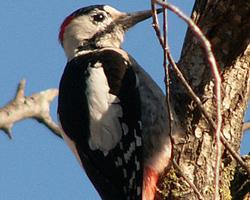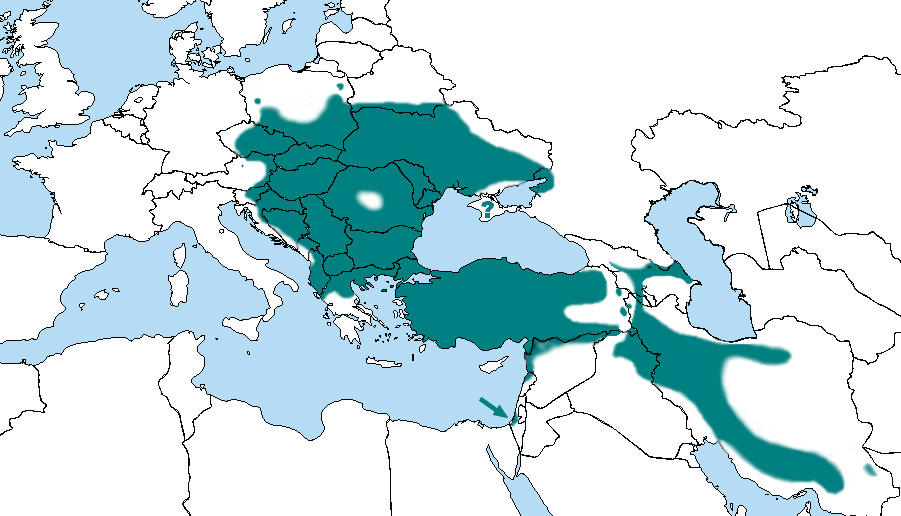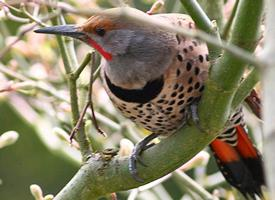
Súlyok és méretek
| Súly | 74-tól 82-ig g |
|---|---|
| Szárnyfesztávolság | 12,5-tól 13,6-ig cm |
Veszélyeztetettség
| Rettenthetetlen |
Állatleírás
The Syrian woodpecker, scientifically named Dendrocopos syriacus, is a fascinating species of bird that is a member of the woodpecker family, Picidae. This bird is primarily found in the eastern Mediterranean region, ranging through Turkey, the Levant, and into parts of the northern Arabian Peninsula. It is a medium-sized woodpecker, with adults typically measuring between 23 to 26 centimeters in length, which is roughly comparable to the size of the Great Spotted Woodpecker, to which it is closely related.The Syrian woodpecker exhibits a striking plumage that is predominantly white with bold black markings. The back is covered in a pattern of black and white stripes, creating a barred effect that provides excellent camouflage against the bark of trees. The wings are also black with white spots, and when in flight, these spots are visible and create a distinctive pattern. The tail is sturdy and black, and it is used as a prop when the bird is clinging to tree trunks.
One of the most distinguishing features of the Syrian woodpecker is its head pattern. Males have a bright red patch on the nape, which is a key identifier, while females have a black nape or only a small red patch. Both sexes have a white forehead, cheeks, and throat, with a black line extending from the bill through the eyes to the sides of the neck, giving it a masked appearance.
The bill of the Syrian woodpecker is strong, chisel-like, and designed for drilling into wood. This bird is well adapted for its arboreal lifestyle. Its feet have two toes pointing forward and two backward, providing a firm grip on tree trunks and branches. The tail feathers are stiff and act as a supportive tripod when the bird is hammering into wood.
Syrian woodpeckers are known for their characteristic behavior of drumming on trees, which is used both to forage for food and to communicate with other woodpeckers. Their diet primarily consists of insects and their larvae, which they extract from crevices in the bark using their long, barbed tongues. They also consume fruits, nuts, and berries, and may occasionally visit bird feeders in areas where they coexist with humans.
The habitat of the Syrian woodpecker is varied but often includes open woodlands, orchards, parks, and gardens. They have a preference for deciduous trees, although they are also found in mixed and coniferous forests. The species is resident throughout most of its range, although some northern populations may migrate short distances in the winter.
During the breeding season, Syrian woodpeckers engage in elaborate courtship displays, which include drumming, calling, and aerial displays. They nest in cavities that they excavate in tree trunks, and both parents share the responsibilities of incubating the eggs and feeding the chicks. The clutch size typically ranges from four to seven eggs, and the young are altricial, meaning they are born blind and featherless, completely dependent on parental care.
While not currently considered endangered, the Syrian woodpecker faces threats from habitat loss and degradation, as well as competition for nesting sites with other cavity-nesting birds and squirrels. Conservation efforts to preserve woodlands and mature trees are crucial for maintaining healthy populations of this and other woodpecker species. The Syrian woodpecker remains an emblematic species of the regions it inhabits, adding to the biodiversity and ecological complexity of these areas.
Előfordulási térkép

Hasonló állatok
Új állatfotók
Top 10 állat
- Dolphin gull (Leucophaeus scoresbii)
- Diana monkey (Cercopithecus diana)
- Moustached guenon (Cercopithecus cephus)
- Stone loach (Barbatula barbatula)
- Greek tortoise (Testudo graeca)
- Galápagos tortoise (Geochelone nigra complex)
- Japanese macaque (Macaca fuscata)
- Russian tortoise (Testudo horsfieldii)
- Common flying dragon (Draco volans)
- Galápagos penguin (Spheniscus mendiculus)


